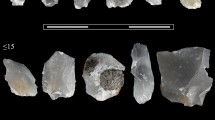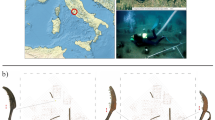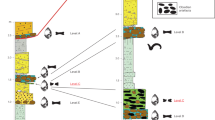Abstract
MOST finds of European Lower Palaeolithic flint artefacts are made from ancient river gravels, either as what are assumed to be concentrations of freshly made implements, suggesting an occupation site, or as abraded material indicating stream redeposition. Verbal description of any abrasion is inaccurate, because lightly abraded specimens may appear fresh to the naked eye. The widths of ridges can be measured on implements with a microscope, thus allowing unworn artefacts and distinct assemblages within a given population to be identified.
This is a preview of subscription content, access via your institution
Access options
Subscribe to this journal
Receive 51 print issues and online access
$199.00 per year
only $3.90 per issue
Buy this article
- Purchase on Springer Link
- Instant access to full article PDF
Prices may be subject to local taxes which are calculated during checkout
Similar content being viewed by others
Author information
Authors and Affiliations
Rights and permissions
About this article
Cite this article
SHACKLEY, M. Stream abrasion of flint implements. Nature 248, 501–502 (1974). https://doi.org/10.1038/248501a0
Received:
Revised:
Issue Date:
DOI: https://doi.org/10.1038/248501a0
This article is cited by
-
The Oldowan of Zarqa Valley, Northern Jordan
Journal of Paleolithic Archaeology (2024)
-
Facing the palimpsest conundrum: an archaeo-stratigraphic approach to the intra-site analysis of SHK Extension (Bed II, Olduvai Gorge, Tanzania)
Archaeological and Anthropological Sciences (2022)
-
Lower and Early Middle Palaeolithic of Southern Britain: the Evidence from the River Test
Journal of Paleolithic Archaeology (2021)
-
An Experimental Approach to Degrees of Rounding Among Lithic Artifacts
Journal of Archaeological Method and Theory (2019)
-
The Stone Age in Northwestern Libya: Observations Along a Pipeline
African Archaeological Review (2015)
Comments
By submitting a comment you agree to abide by our Terms and Community Guidelines. If you find something abusive or that does not comply with our terms or guidelines please flag it as inappropriate.



